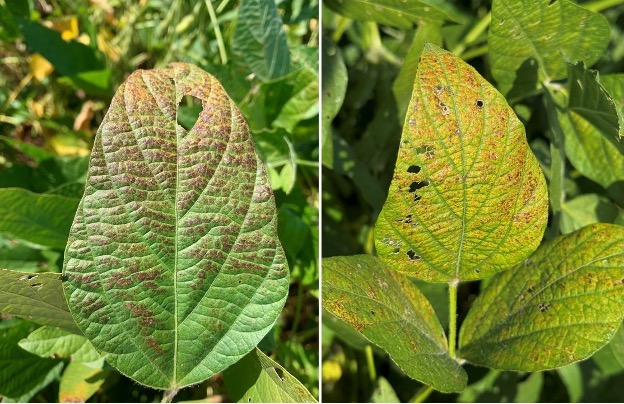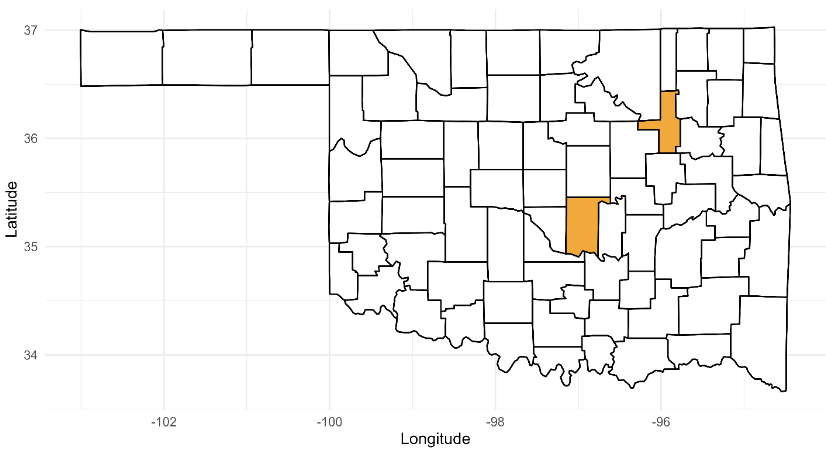First Report of Resistance to QoI-Fungicides in Pathogens Causing Cercospora Leaf Blight of Soybean in Oklahoma
Introduction
Soybean (Glycine max) is an important crop in Oklahoma and an essential crop rotation. However, this crop is constantly threatened by various diseases (seedling, foliar, root rot, stem, seed) caused by plant pathogens, which pose a significant risk to crop yields and quality. The type of diseases and associated yield losses change annually and regionally depending on environmental and cropping conditions, including weather factors, cultivar selection, tillage practices, crop rotation and disease history in the field.
One common foliar disease often observed affecting soybean leaves in commercial fields across Oklahoma is Cercospora leaf blight (CLB) of soybeans. Historically, Cercospora kikuchii was believed to be the only patho-gen associated with CLB, but results from a 2023 study conducted in a large geographic area in the U.S. reported that several Cercospora species cause CLB with C. cf. flagellaris being more predominant. Cercospora leaf blight is considered to be a mid to late-season disease. The yield damage caused by this disease depends on how early infection of soybean plants occurs in reproductive stages and the weather conditions that favor disease development. Estimated soybean yield losses from CLB between 2012 and 2019 ranged from 120,918 to 347,000 metric tons in the U.S. and Ontario, Canada.
Symptoms and Signs
The fungus can infect soybean plants early in the grow-ing season. Still, symptoms are not observed in most cases until the beginning of seed set (R5) or throughout the seed set. Cercospora leaf blight symptoms can be commonly mistaken for early senescence or sunburn. Characteristic symptoms developed initially as small, reddish-purple, angular to irregular lesions on the upper leaflets surface limited by the upper surface of leaflets, limited by the leaf vein. As the disease progresses, the infected leaves have a leathery feel and appearance, and the upper surface of the leaf develops purplish-red to bronze discoloration (Figure 1). Heavily infected leaves rapidly turn yellow and drop Signsfrom the plant, mimicking natural leaf senescence, but the petioles of fallen leaves remain attached to the stems. The lower leaves of the plant remain green. Premature defolia-tion resulting from severe foliar symptoms can cause yield losses. In severe situations and on susceptible soybean varieties, other aboveground parts of the plant can also be infected, including petioles, main stem and pods. The pathogens causing CLB are also associated with purple seed stain of soybean (PSS). However, there is no consistent correlation between the development of foliar symptoms and the occurrence of stained seeds.
Figure 1. Symptoms of Cercospora leaf blight on soybean leaves in Oklahoma during the 2023 soybean growing season. The picture on the left shows dark purplish-red discoloration, and the picture on the right shows leaves with bronze discoloration. Photo courtesy Maira Duffeck, Oklahoma State University.
Disease Cycle
The primary inoculum of the fungus is usually conidiaoriginating from infected soybean debris that overwinters in the soil surface and sporulates readily in the spring. Hot and humid conditions (75 to 80°F; >75% RH) and eight to 24 hours of leaf wetness during soybean reproductive stages favor infection and conidia production (Figure 2). The fungi spores are dispersed by wind or rain splash to new soybean tissue where secondary infections occur. In addition, dispersal of the pathogen could be favored by infected seeds. The pathogens can also reproduce and survive on additional crops and weeds in the fields (cotton, pokeweed, ragweed, etc.), contributing inoculum to the next growing seasons.
Figure 2. Disease cycle of Cercospora leaf blight of soybean (Crop Network Protection, 2019).
Disease Management
Rotation to non-host crops, such as alfalfa, corn or small grains, is recommended to reduce primary inoculum levels from one growing season to another. Tillage can be used to bury soybean crop residue and reduce the pathogen's survival. Another recommended cultural method is planting early maturing cultivars to avoid the hottest and humid part of the growing season.
Although commercially available soybean varieties claim to be resistant to CLB, inconsistency in varietal resistance to the disease has been reported in differentyears and locations. Planting only certified and disease-free seed is also recommended for the management of CLB.
Fungicide applications during the reproductive stages of soybean development are recommended for managing CLB. One application of a registered fungicide at the beginning pod growth stage (R3) may provide adequate suppression of the disease. However, over the years, many available fungicides have become no longer effective for managing CLB due to documented cases of resistance within fungal populations in the U.S., especially fungicides of the quinone outside inhibitor (QoI) group commonly known as strobilurins and the methyl benzimidazole carbamates (MCB) group.
Fungicide Resistance in Oklahoma
In recent years, a decline in the efficacy of QoI fungicides in managing CLB in the U.S. has been observed. Reports of Cercospora populations causing CLB that are resistant to strobilurin fungicides have already been described in Alabama, Kentucky, Mississippi, Missouri, Tennessee, Texas and Louisiana. Cercospora leaf blight fungi with resistance to QoI fungicides have been suspected in Oklahoma. Because of that suspicion, soybean leaves showing symptoms of CLB were collected during the 2023 growing season from two commercial fields in Tulsa and Pottawatomie counties located in the northeast and central parts of the state (Figure 3). Under laboratory conditions, the leaf samples showing symptoms of CLB were processed for pathogen isolation and characterization based on morphology and molecular-based techniques.
A total of 44 isolates of Cercospora spp. associated with CLB symptoms were collected during the 2023 growing season. Of the 44 isolates obtained, 41 (~ 93%) were sensitive to QoI fungicides, while 3 (~7%) were QoI-resistant. This is the first report of resistance in population of CLB pathogen to QoI fungicides in Oklahoma and provides a foundation for continuous monitoring of pathogen population. Although this study was based on a collection of 44 isolates, findings from this study suggest that the management of CLB with QoIfungicides in Oklahoma remains a viable option since 93% of the pathogen population is still sensitive to QoI-fungicides. Additional surveys will be required to monitor the spread of the resistant population across the state.
Figure 3. Map of Oklahoma highlighting the counties where soybean leaves showing symptoms of Cercospora leaf blight (CLB) were col-lected during the 2023 growing season. Photo courtesy Maira Duffeck, Oklahoma State University



